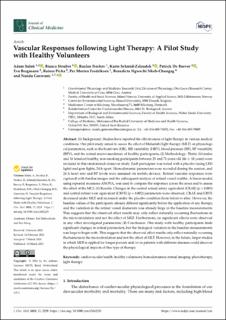Vascular Responses following Light Therapy: A Pilot Study with Healthy Volunteers
Saloň, Adam; Steuber, Bianca; Neshev, Ruslan; Schmid-Zalaudek, Karin; De Boever, Patrick; Bergmann, Eva; Picha, Rainer; Fredriksen, Per Morten; Nkeh-Chungag, Benedicta Ngwechi; Goswami, Nandu
Peer reviewed, Journal article
Published version
Permanent lenke
https://hdl.handle.net/11250/3099877Utgivelsesdato
2023Metadata
Vis full innførselSamlinger
Sammendrag
(1) Background: Studies have reported the effectiveness of light therapy in various medical conditions. Our pilot study aimed to assess the effect of Maharishi light therapy (MLT) on physiological parameters, such as the heart rate (HR), HR variability (HRV), blood pressure (BP), BP variability (BPV), and the retinal microvasculature of healthy participants; (2) Methodology: Thirty (14 males and 16 females) healthy, non-smoking participants between 23 and 71 years old (46 ± 18 years) were included in this randomized crossover study. Each participant was tested with a placebo (using LED light) and gem lights, 24 h apart. Hemodynamic parameters were recorded during the session, and 24 h heart rate and BP levels were assessed via mobile devices. Retinal vascular responses were captured with fundus images and the subsequent analysis of retinal vessel widths. A linear model, using repeated measures ANOVA, was used to compare the responses across the sexes and to assess the effect of the MLT; (3) Results: Changes in the central retinal artery equivalent (CRAE) (p < 0.001) and central retinal vein equivalent (CRVE) (p = 0.002) parameters were observed. CRAE and CRVE decreased under MLT and increased under the placebo condition from before to after. However, the baseline values of the participants already differed significantly before the application of any therapy, and the variation in the retinal vessel diameters was already large in the baseline measurements. This suggests that the observed effect results may only reflect naturally occurring fluctuations in the microcirculation and not the effect of MLT. Furthermore, no significant effects were observed in any other investigated parameters; (4) Conclusion: Our study with healthy participants finds significant changes in retinal parameters, but the biological variation in the baseline measurements was large to begin with. This suggests that the observed effect results only reflect naturally occurring fluctuations in the microcirculation and not the effect of MLT. However, in the future, larger studies in which MLT is applied for longer periods and/or in patients with different diseases could discover the physiological impacts of this type of therapy.

